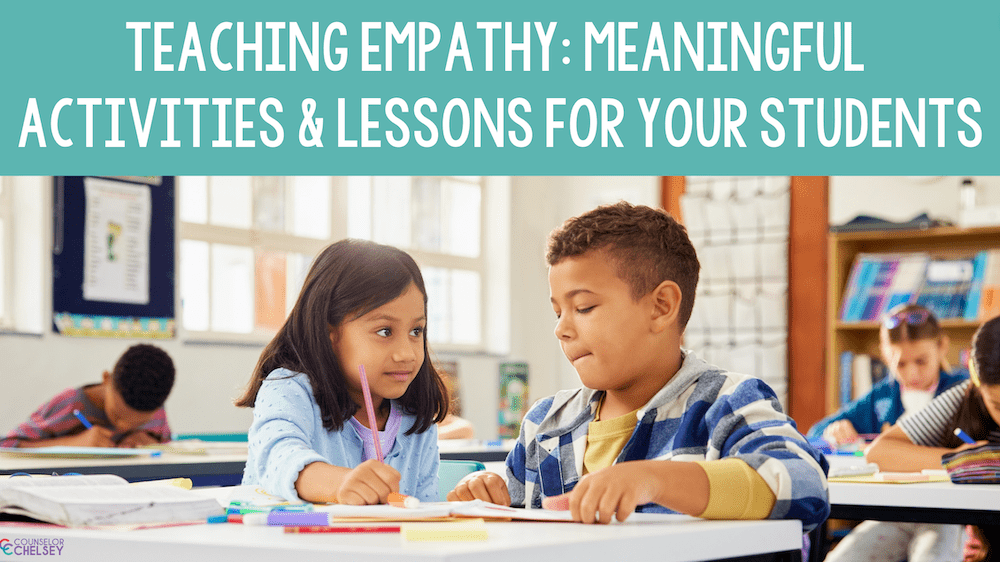Teaching Empathy: Meaningful Activities & Lessons For Your Students
If you’ve spent any time working with children, you’ve likely seen the short-term benefits of empathy. When we show empathy to one another, we’re more likely to be helpful, kind, and encouraging. There are also studies that show that increased empathy can lead to a safer school community, increased positive relationships, and even greater academic success.
This, of course, encourages us to ask ourselves how we can help kids become more empathetic. Research shows that we learn best when we’re given information/training at intervals instead of all at once. Because of that, I’ve broken down these empathy lessons and activities into two parts - understanding/identifying feelings, and explicit instruction about empathy. Pairing these two concepts together in separate lessons can help kids become more familiar with their own feelings, and the feelings of others, so that they can respond with empathy.
This post contains affiliate links. Please review my full disclosure policy for additional information.
Activities & Lessons About Understanding Feelings
Identifying and understanding emotions is a key component of empathy. This includes identifying how other people are feeling and understanding what it’s like to experience that emotion.
Ways To Help Kids Understand Their Own Feelings
This post includes 5 ways to use a feelings chart!
Make a habit out of doing a feelings check-in. A “feelings check-in” gives kids a chance to take time to think about how they’re feeling. There are many ways you can do this. Try simply asking kids how they are feeling, having them write or draw how they are feeling, or showing them a feelings chart and have them point to/circle how they are feeling.
Name your own feelings. Talking about your feelings can help kids better understand their own. It gives kids a chance to learn and understand more about feelings that they’re unfamiliar with, giving them a chance to expand their emotional vocabularies. Plus, by modeling this skill, you can normalize talking about and identifying your feelings.
Help kids identify how they’ve felt in certain situations. Similar to doing a “feelings check-in,” helping kids reflect on how they have felt in past situations can be done in many ways. When talking informally with kids about things that have happened, you can simply ask them how they felt in that situation. You can also make this a more formal lesson/activity by talking about different feelings and asking kids to identify times when they have experienced that emotion.
Ways To Help Kids Understand The Feelings Of Others
Talk about how book or TV characters are feeling. Read alouds are a great way to help kids practice identifying the feelings of others. While you’re reading the book, you can stop at various points and ask your students how they think the characters in the book are feeling. You can also ask the kids to share how they know that the characters are feeling this way. This allows kids to practice thinking about how certain situations might affect someone’s feelings. Plus, if kids are looking at picture books, the illustrations can teach kids to look at body language or facial expressions to determine how someone might be feeling.
Play feelings charades. Feelings charades is the perfect game for helping kids learn to identify how others are feeling. In the game, the kids will take turns acting out a feeling without speaking. Then, the other student(s) will have to guess what it is. This gives kids practice looking at facial expressions, body language, and nonverbal communication to identify someone’s feelings.
OTHER FEELINGS & EMOTIONS RESOURCES
Activities & Lessons About Showing Empathy
As we teach kids about empathy, it’s important that we help them understand what empathy is, and what it looks like in real-life situations.
Defining Empathy
Taking time to explicitly define and explain what empathy actually means is a great first step for your empathy lessons.
A helpful, kid-friendly definition of empathy is: Understanding what someone else is feeling and experiencing. These three questions can also make it easier for kids to understand what empathy looks like in real life.
How is the other person feeling?
What does the other person need?
How can I help the other person?
Activities to help kids practice empathy
Read the book Hey, Little Ant by Philip and Hannah Hoose. This book is one of my all-time favorites. In it, the main character contemplates squishing an ant. As he does, the ant shows the boy that even though he is small, his life is important! The book ends by asking the reader to make the decision of whether or not the boy should squish the ant. It shows the importance of considering different perspectives and points of view.
Role play with practice scenarios. Come up with your own scenarios, use these free ones, or use situations in books or shows. Then, help kids work through the three questions from above. Ask them to consider how the person in the scenario is feeling, what the person needs, and how we can help!
Talk about perspective taking. Part of the reason that empathy can be difficult is because it can be easy to stay focused on our own experience and the way that we view a situation. Perspective-taking exercises help kids understand that different people may experience situations differently. One of my favorite ways to talk about this is by using the folk tale “The Blind Men And The Elephant.” The Peace Corps has some lesson ideas here that you can use with this story.
Use these activities with the book Hey, Little Ant.
other EMPATHY resources
These empathy lessons and activities will help kids better understand their own feelings and the feelings of others so that they can respond with empathy.









